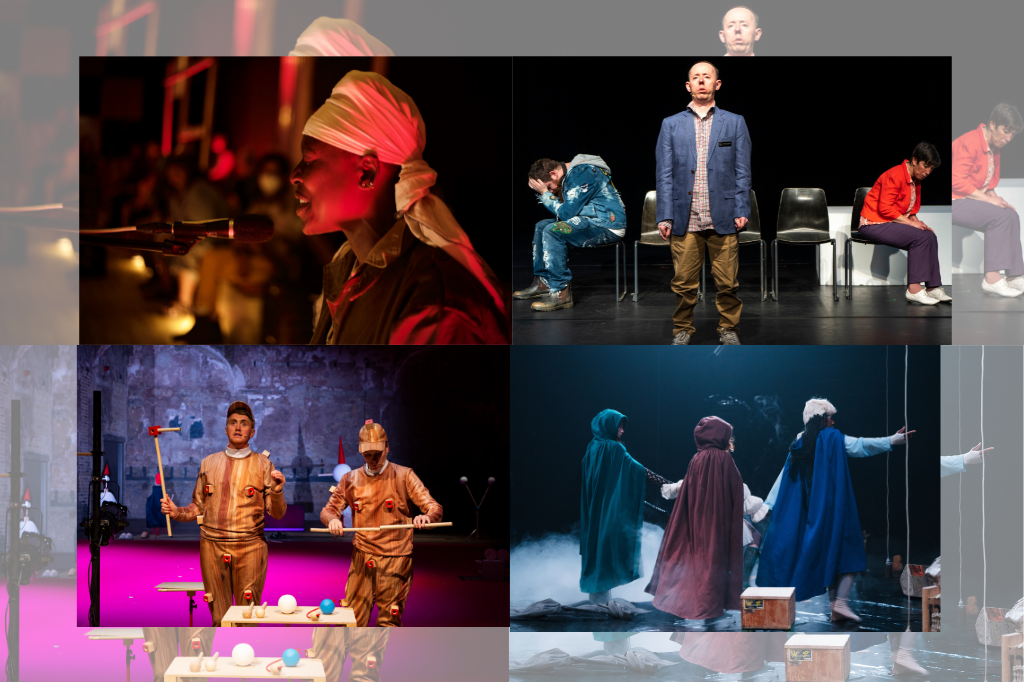REVIEW: Festival TransAmériques — Weekend One
Bonjour hi!
On behalf of Intermission, senior editor Aisling Murphy travelled to Montreal to review the first week of shows in Festival TransAmériques, the exhilarating gala of live performance which attracts experimental, provocative works from around the globe. This year’s iteration of FTA, co-headed by Martine Dennewald and Jessie Mill, brings together 24 productions from 21 different countries.
Below is a set of reviews from me for the first weekend (May 25-28), and editorial advisor Karen Fricker will be finishing out the festival next week. We’ll come together at the end of the festival with a round-up of our final thoughts.
The Making of Pinocchio — Rosana Cade and Ivor MacAskill, Glasgow
Puppets. An inflatable noodle-man. Forced perspective. Wooden genitals. Real genitals.
The Making of Pinocchio, staged in the cozy but comfortable Théâtre Rouge du Conservatoire, seemingly borrows from every imaginable aesthetic in its reimagining of the classic fairy tale. When we meet Rosana and Ivor, we’re told they’re a real-life couple with an affinity for making children’s theatre. And you can see that reverence for youth in the skilled actors’ movements, their gentle voices and whimsical scenography.
The show opens with a tangle of cameras and film equipment, smartly arranged so that we can see both the real people and the end result on a large screen. Cade and MacAskill make frequent use of imaginative filmic angles, so that in their alternating roles as puppets they appear half the size of each other, and the effect is superb (and precise — you can sense the care that’s gone into perfecting each shot).
But the play quickly — ahem — transitions, and in this lies the beating heart of this show. Pinocchio in this instance is an allegory for transition — from female to male, from lesbian to queer, from theatre to film — and the kaleidoscope of techniques used to delight the audience demonstrates the sharp edges of life as a trans person in the U.K. We pivot from Pinnochio into the real lives of Cade and MacAskill, a relationship formed on a foundation of a complicated student-professor power dynamic, and we learn more and more about their respective journeys in queerness. With interesting echoes of Tristan Whiston’s recent show Trace at TPM, we see a video of MacAskill, playing ukulele in the nude prior to his transition, while the real-life MacAskill sings along, harmonizing with his former self.
In a moment of utter provocation, MacAskill and Cade tell us an outlandish, clearly made-up story about the artistic director of FTA, who supposedly keeps a barrage of trans men in the festival’s basement in a red rubber room. Enter inflatable noodle-man, who flails incessantly while MacAskill, Cade, and their stagehands simulate group sex with each other and the beast.
The Making of Pinocchio tests every possible limit of decorum but is so very fun it can’t be faulted. At a neat two hours with no intermission, it meandered just a tad for me towards the end, but as Cade and MacAskill conclude in their final scene, the show will keep changing as they do.
Nehanda — nora chipaumire, United States and Zimbabwe
What immediately gleams from Nehanda’s logistical information is its run time, billed at a staggering five and a half hours.
It’s a long show for a long story. Nehanda interrogates the history of colonialism in Zimbabwe, specifically focusing on the trial in which Queen Victoria convicted Charwe Nyakasikana, a leader of the anti-colonialist movement in Rhodesia at the end of the nineteenth century. Divided into five multi-part acts, the dance-opera conglomerate strives to cover much emotional and historical ground. Inside a cavernous, warehouse-like room at Théâtre Espace GO, horns blare, voices exalt, and people dance, costumed in a riveting blend of contemporary streetwear and more timeless robes. While two rows of chairs surround the central playing space, milk cartons also dot the stage, offering alternative seating for those who wish to be more immersed in the performance.
Where Nehanda stumbles for me is that run time — much of the four-hour-long first section repeats over and over and over. While the dramaturgical implications of an oppressively repetitive historical cycle are clear, experiencing it is something else entirely. A repeated motif in chipaumire’s score is loud sections of horns and whistles — so loud that earplugs are offered to the audience at the door — and hours upon hours of cacophony without a moment of silence to punctuate the chaos grow at times tiresome.
Still, Nehanda is visually scrumptious, an assault on the senses and an achievement in durational performance. While it didn’t always land for me, the hoardes of audience members dancing alongside the performers seemed to revel in the show’s energy — and its horns.
Lay Hold to the Softest Throat — Ellen Furey, Montreal
What are the limits of the human throat?
Furey’s dance piece, staged in the large Chapelle Scènes in a traditional proscenium configuration, attempts to answer this question, choreographing not only the body but the voice. Three female-presenting bodies navigate the stage, which is littered with electronic detritus and musical keyboards. The dancers at times become quite rude — more than once does a performer play the piano using her private area — and they alternate long monologues, speaking in different registers and showcasing the abilities (and limitation) of their vocal cords as they wisp around the space.
This is another one which errs towards loudness — earplugs are once again on offer for audience members — but the opening, noisier sequence gives way to something more graceful and less grating by its final beats, and even ends in a song for three voices, sung in yummy close harmonies.
There’s much to like in Furey’s choreography, particularly the fluidity of her dancers, able to switch styles on a dime. The corporeal and vocal elements of the direction felt rather separate for me — I kept wishing for a moment in which the exploration of the throat and exploration of the body converged into something more all-consuming — but overall the piece succeeds at digging into its research question, searching high and low for the extremities of vocal ability.
The shadow whose prey the hunter becomes — Back to Back Theatre, Australia
A standout favourite for me.
Back to Back Theatre is a collective of artists based near Melbourne, a professional theatre company for actors with intellectual disabilities. These actors are equal parts of the creation process, guided only slightly by director Bruce Gladwin. The end result of their collaboration is a rich, complicated, often funny aesthetic in which enormous ideas about the fate of the human race come face-to-face with the everyday realities of life as a disabled person.
The shadow whose prey the hunter becomes, presented in the lovely Théâtre Prospero space, covers an astonishing amount of ground in just over an hour — how does one navigate a land acknowledgement when they have trouble speaking? How will AI replace humans — and how does that process mirror the abuse disabled people already face in today’s society? When a famous actor like Kevin Spacey commits unspeakable crimes, are we still allowed to appreciate their work?
Those questions and more explode inside a contextless “community meeting,” during which the three actors — Sarah Mainwaring, Simon Laherty, and Scott Price — hurl provocative conversation starters at one another and at us, always drawing our focus to the ugly truth of modern society’s treatment of disabled people.
Behind the actors hangs a screen, which offers captions in both English and French of what the actors are saying. They hate these surtitles, they tell us — the onus should be on the audience to listen closer — but they put up with the captioning, understanding the barrier their speech patterns can place between themselves and the world. The screen behind the actors occasionally gains a mind of its own, correcting words, entering into dialogue with the actors, even posing as the embodiment of AI — but importantly, it never overpowers the very human work happening onstage.
Gladwin, Mainwaring, Laherty, and Price have themselves a powerful knockout of a production, and, gloriously, we’ll be getting it in Toronto in 2024 at Canadian Stage. These actors are funny, and irreverent, and truthful, and meticulous in their storytelling, and their final warning about the elimination of human intelligence rings hauntingly prudent.
Intermission reviews are independent and unrelated to Intermission’s partnered content. Learn more about Intermission’s partnership model here.















Comments